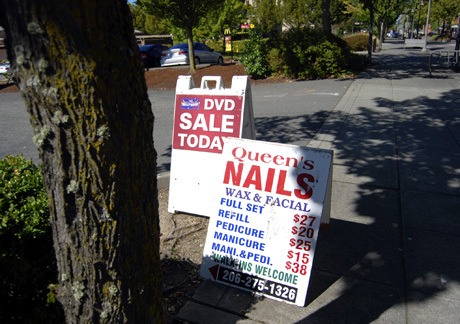Uptick in street sign clutter result of poor economy, local elections
Once again, the city has become proactive in reminding Island businesses and residents to comply with its temporary sign ordinance. Due to the recent primary elections, the struggling economy and a competitive real estate market, the Island has seen an abundance of temporary signs pop up in the Town Center and residential areas. These signs range from fold-out sandwich boards used by local businesses to “For Rent” placards stapled to neighborhood telephone poles.
Although most businesses and residents follow city code, City Development Services (DSG) analyst Joyce Trantina said that, every so often, Island signage starts to “get out of hand.” This is especially true during the election seasons.
“Historically, when elections occur, that gets people’s juices going. The Island starts to look more cluttered than normal,” she said. “We just came from some primaries with a lot of election signs.”
Indeed, the city has received a noticeable increase in the number of complaints about temporary signs cluttering roads, sidewalks and neighborhoods.
The phone calls began coming in a few months ago, Trantina said. There were enough of them to persuade the DSG department to print off and distribute copies of the city’s temporary sign regulations. The one-page flyer is stacked on counters at City Hall, the Mercer Island Chamber of Commerce and is hand-delivered to those individuals guilty of breaching the temporary sign ordinance.
DSG compliance officer Jimmi Serfling has personally delivered the flyers herself. Although she has handed out quite a few in recent weeks, Serfling does not consider the issue a serious problem.
“For us, the problem ebbs and flows. As more signs show up, more complaints come in. So we respond with an educational flyer,” she said.
The compliance officer agrees with Trantina that the current economic slump — on top of regional elections — has exacerbated the problem.
“It’s a continual real estate issue,” she said. “[Islanders] are trying to sell and rent their homes. And that’s a challenge for people right now.”
Businesses, too, are eager to bring passersby into their doors. Town Center restaurants advertise their open hours, gift shops proclaim special sales and apartment buildings welcome potential residents with “Open House” signs and balloons. Such is today’s competitive market.
Most of these signs, Serfling and Trantina agree, are in compliance. It’s just that some, well, aren’t.
“We don’t want to discourage businesses from advertising, but once one sign goes up, another group of them follows, and soon sidewalks become difficult to maneuver around,” Trantina said.
According to city provisions, “signs shall not obstruct vehicular or pedestrian traffic.” This often is the problem with A-frame boards in the Town Center.
Other provisions target residential areas. For example, according to city regulations, signs “may not be placed on public property except for publicly owned rights-of-way,” which must be “adjacent to a single family dwelling only with permission of adjoining property owners … clear of tree/vegetation and structures … and may not be attached to utility poles, traffic signs, street signs or trees.”
The city carries the right to confiscate any signs that violate regulations. The owner may retrieve his sign by contacting City Hall staff.
Often, the city will catch people stapling poster-board signs to telephone poles or stop signs.
Others abide by regulations, but leave their placards up for longer than city regulations allow — a maximum of 90 days during any 365-day period. This stipulation, however, does not apply to political signs, which make up a majority of residential complaints. But if the “vote so-and-so” posters are not breaking regulation, the city’s hands are tied. And most candidates are well versed in the rules.
“Sign codes are always challenging to address in terms of finding a balance,” Trantina pointed out.
The city’s solution to the problem, according to both DSG representatives, is to address each case individually, with manners and tact.
“We’re just trying to help re-educate people that we do have a sign code, and here’s what it is,” Serfling said. “Now that we have this flyer, I bring it when I get complaints about, say, garage sale signs plastered on poles. Joyce has been working with the Chamber of Commerce to curb violations in the Town Center. The best way to deal with this is to work as a whole.”
For a full list of temporary sign regulations, go to www.mercergov.org. Questions can be directed to the DSG department at (206) 275-7600.



